

Compact Muon Solenoid
LHC, CERN
| CMS-SUS-21-008 ; CERN-EP-2024-000 | ||
| Combined search for electroweak production of winos, binos, higgsinos, and sleptons in proton-proton collisions at $ \sqrt{s} = $ 13 TeV | ||
| CMS Collaboration | ||
| 3 February 2024 | ||
| Phys. Rev. D 109 (2024) 112001 | ||
| Abstract: A combination of the results of several searches for the electroweak production of the supersymmetric partners of standard model bosons, and of charged leptons, is presented. All searches use proton-proton collision data at $ \sqrt{s}= $ 13 TeV recorded with the CMS detector at the LHC in 2016-2018. The analyzed data correspond to an integrated luminosity of up to 137 fb$ ^{-1} $. The results are interpreted in terms of simplified models of supersymmetry. Two new interpretations are added with this combination: a model spectrum with the bino as the lightest supersymmetric particle together with mass-degenerate higgsinos decaying to the bino and a standard model boson, and the compressed-spectrum region of a previously studied model of slepton pair production. Improved analysis techniques are employed to optimize sensitivity for the compressed spectra in the wino and slepton pair production models. The results are consistent with expectations from the standard model. The combination provides a more comprehensive coverage of the model parameter space than the individual searches, extending the exclusion by up to 125 GeV, and also targets some of the intermediate gaps in the mass coverage. | ||
| Links: e-print arXiv:2402.01888 [hep-ex] (PDF) ; CDS record ; inSPIRE record ; HepData record ; CADI line (restricted) ; | ||
| Figures & Tables | Summary | Additional Figures | References | CMS Publications |
|---|
| Figures | |
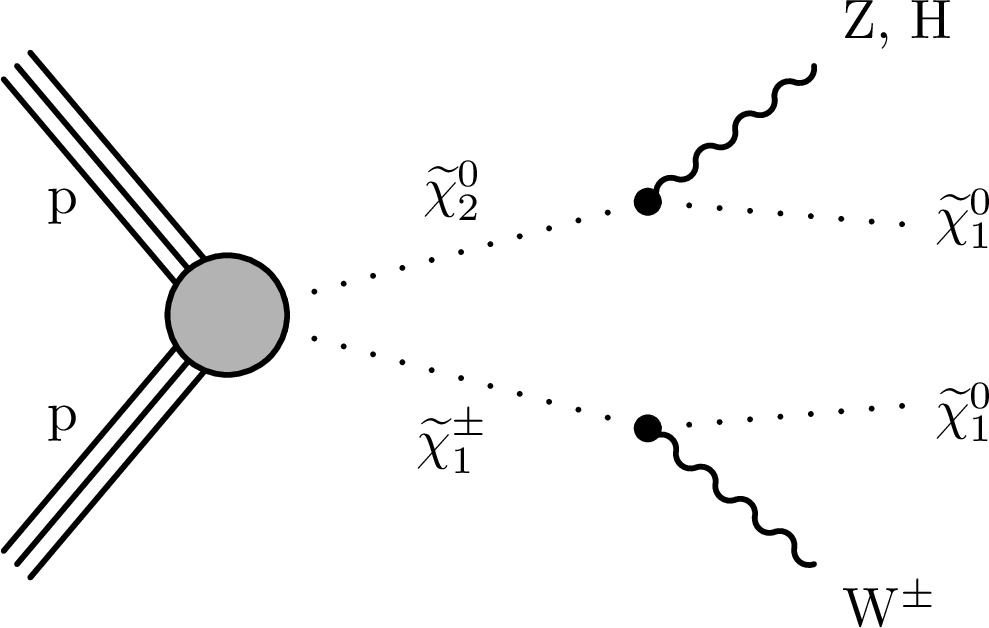
png pdf |
Figure 1:
Wino-bino model: production of $ \tilde{\chi}_{2}^{0} $ and $ \tilde{\chi}_{1}^{\pm} $, with the $ \tilde{\chi}_{2}^{0} $ decaying to either a Z or H boson and a $ \tilde{\chi}_{1}^{0} $, and the $ \tilde{\chi}_{1}^{\pm} $ decaying to a W boson and a $ \tilde{\chi}_{1}^{0} $. |

png pdf |
Figure 2:
GMSB model: pair production of $ \tilde{\chi}_{1}^{0}\tilde{\chi}_{1}^{0} $. The $ \tilde{\chi}_{1}^{0} $ particles each decay to a $ \tilde{\mathrm{G}} $ with the emission of an SM gauge boson: (left) both Z, (middle) one Z and the other H, and (right) both H. Soft fermions from decays of nearly degenerate neutralinos and charginos are omitted from these diagrams. |

png pdf |
Figure 2-a:
GMSB model: pair production of $ \tilde{\chi}_{1}^{0}\tilde{\chi}_{1}^{0} $. The $ \tilde{\chi}_{1}^{0} $ particles each decay to a $ \tilde{\mathrm{G}} $ with the emission of two Z bosons. Soft fermions from decays of nearly degenerate neutralinos and charginos are omitted from the diagram. |
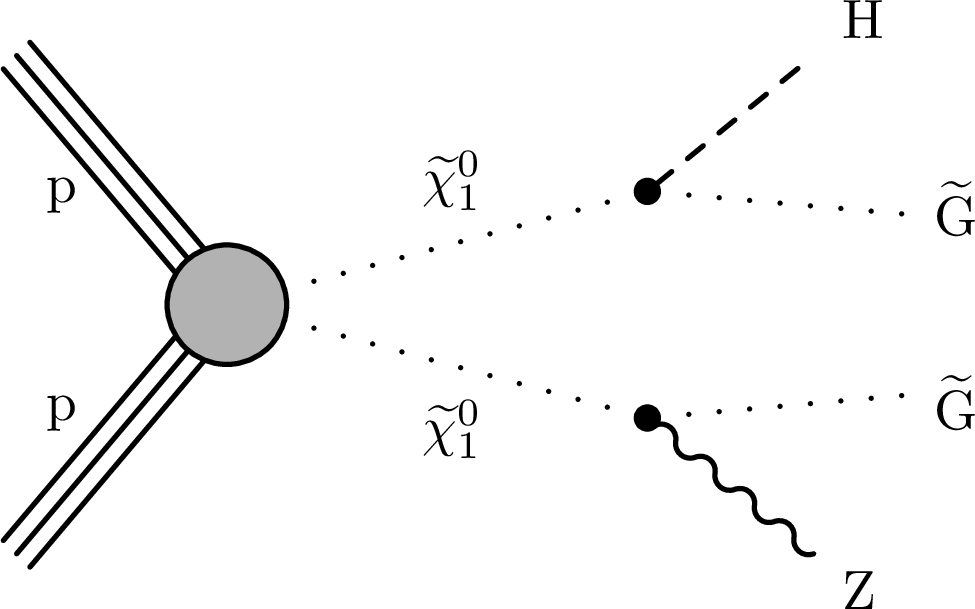
png pdf |
Figure 2-b:
GMSB model: pair production of $ \tilde{\chi}_{1}^{0}\tilde{\chi}_{1}^{0} $. The $ \tilde{\chi}_{1}^{0} $ particles each decay to a $ \tilde{\mathrm{G}} $ with the emission of one Z boson and one H boson. Soft fermions from decays of nearly degenerate neutralinos and charginos are omitted from the diagram. |
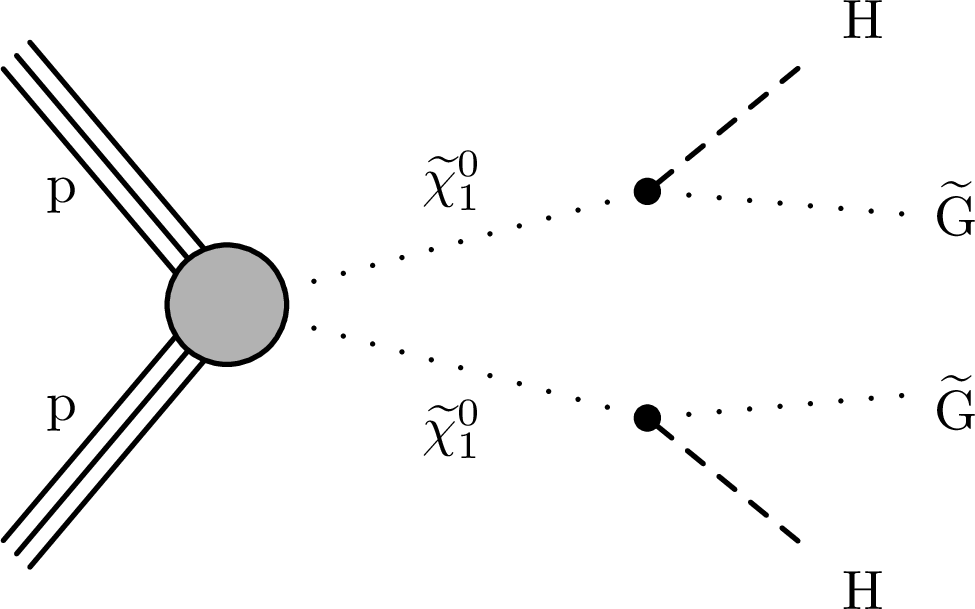
png pdf |
Figure 2-c:
GMSB model: pair production of $ \tilde{\chi}_{1}^{0}\tilde{\chi}_{1}^{0} $. The $ \tilde{\chi}_{1}^{0} $ particles each decay to a $ \tilde{\mathrm{G}} $ with the emission of two H bosons. Soft fermions from decays of nearly degenerate neutralinos and charginos are omitted from the diagram. |

png pdf |
Figure 3:
Higgsino-bino model: (left) the production of a pair of charginos followed by their decays to W bosons and the LSP, (middle) the production of a pair of neutralinos followed by decays to H bosons and the LSP, and (right) the production of chargino-neutralino pairs followed by decay of the chargino (neutralino) to a W (H) boson and the LSP. |
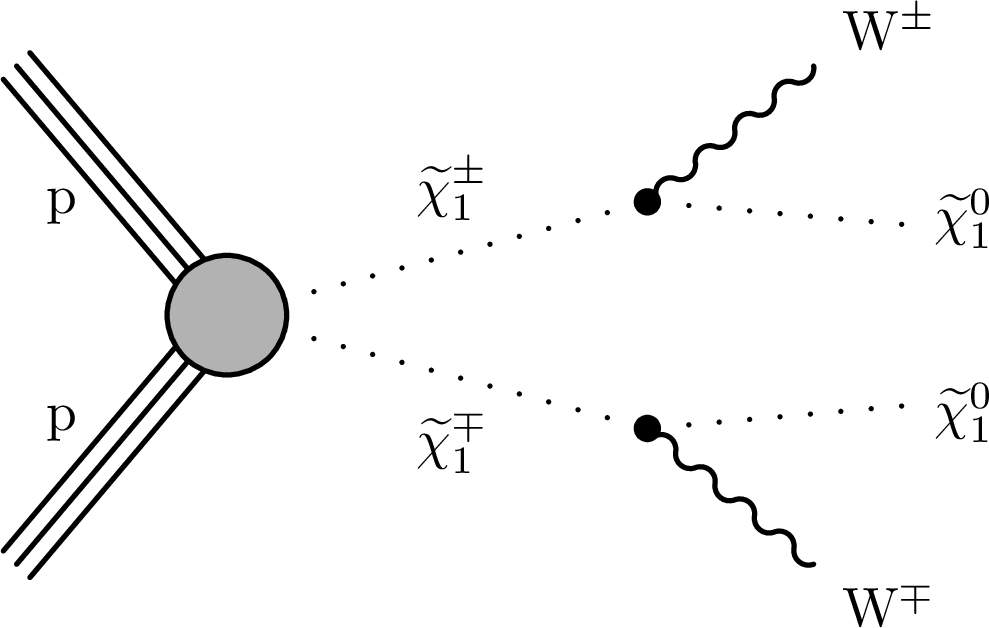
png pdf |
Figure 3-a:
Higgsino-bino model: the production of a pair of charginos followed by their decays to W bosons and the LSP. |
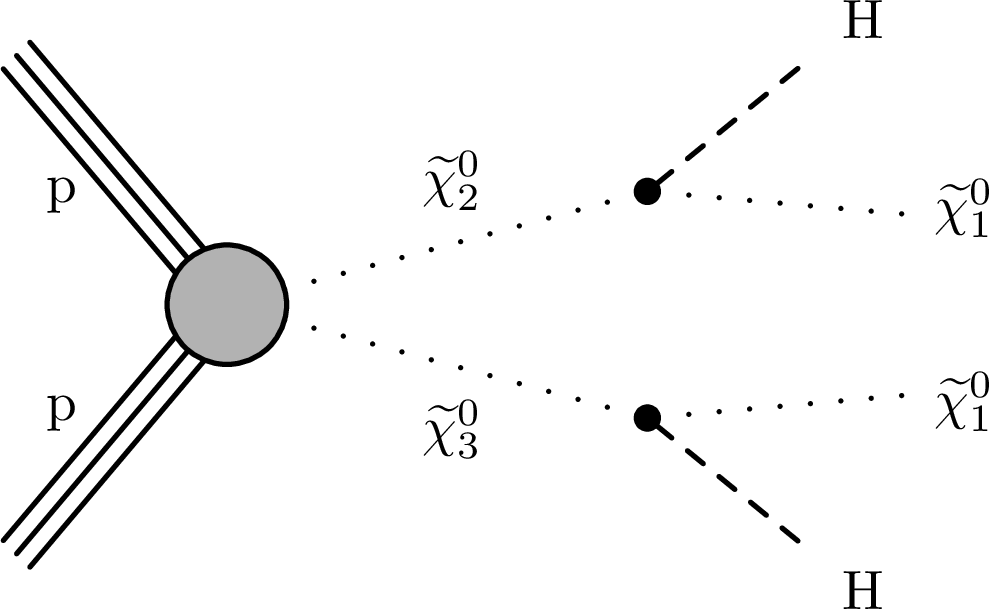
png pdf |
Figure 3-b:
Higgsino-bino model: the production of a pair of neutralinos followed by decays to H bosons and the LSP. |

png pdf |
Figure 3-c:
Higgsino-bino model: the production of chargino-neutralino pairs followed by decay of the chargino (neutralino) to a W (H) boson and the LSP. |
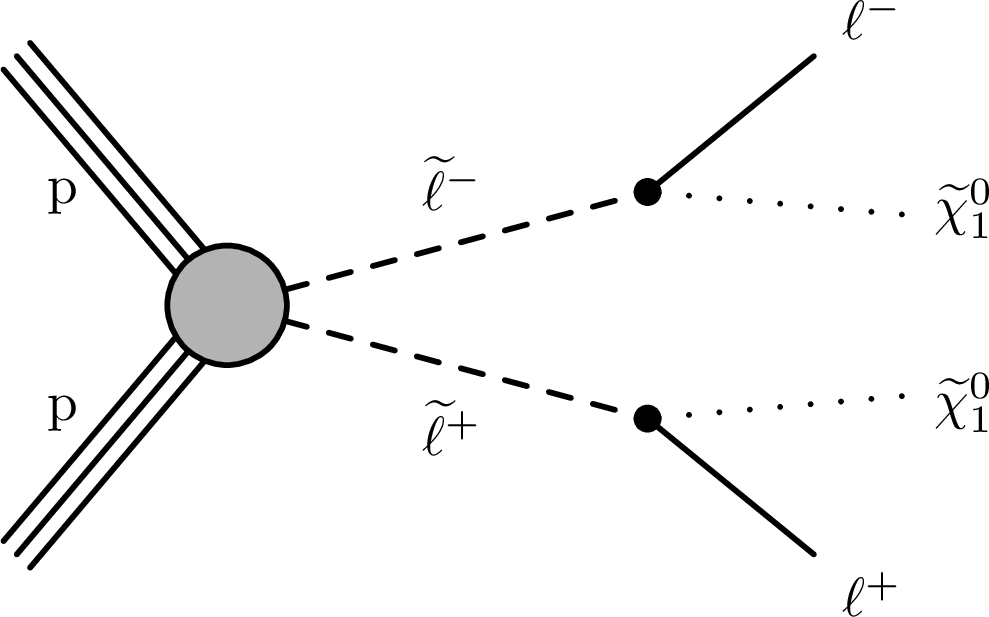
png pdf |
Figure 4:
Slepton-neutralino model: direct slepton pair production, with each slepton decaying into a lepton and a $ \tilde{\chi}_{1}^{0} $ LSP. |
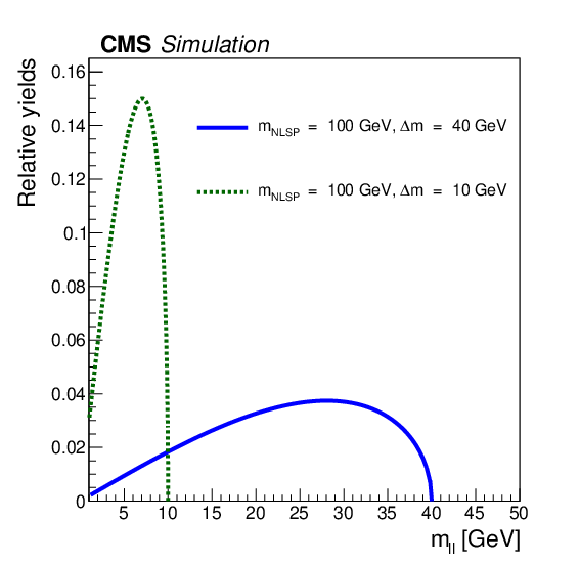
png pdf |
Figure 5:
``2/3$\ell $ soft'' search: dilepton mass spectrum for two mass hypotheses with the same NLSP mass (100 GeV) and different mass splittings $ \Delta m $ (40 or 10 GeV), both corresponding to analytical phase space only calculations. The distributions have a kinematic endpoint at the mass splitting. |

png pdf |
Figure 6:
``2/3$\ell $ soft'' search: post-fit distributions of the $ \text{M}(\ell\ell) $ variable for the low- (upper left), medium- (upper right), high- (lower left), and ultrahigh- (lower right) $ p_{\mathrm{T}}^\text{miss} $ bins in the ``2$ \ell $ soft'' signal region of Ref. [72]. These distributions are based on the parametric binnings derived for signal mass points with $ \Delta m = $ 20 GeV. The pre-fit signal distribution for $ m_{\tilde{\chi}_{1}^{\pm}} = m_{\tilde{\chi}_{2}^{0}}=$ 200 GeV, $m_{\tilde{\chi}^{0}}= $ 180 GeV is overlaid for illustration. ``Nonprompt'' refers to the background contribution arising from nonprompt or misidentified leptons. |
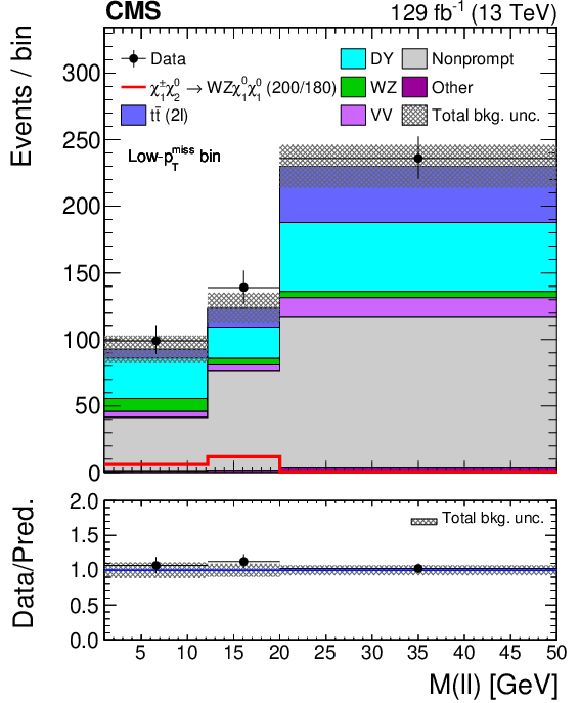
png pdf |
Figure 6-a:
``2/3$\ell $ soft'' search: post-fit distribution of the $ \text{M}(\ell\ell) $ variable for the low-$ p_{\mathrm{T}}^\text{miss} $ bin in the ``2$ \ell $ soft'' signal region of Ref. [72]. The distribution is based on the parametric binnings derived for signal mass points with $ \Delta m = $ 20 GeV. The pre-fit signal distribution for $ m_{\tilde{\chi}_{1}^{\pm}} = m_{\tilde{\chi}_{2}^{0}}=$ 200 GeV, $m_{\tilde{\chi}^{0}}= $ 180 GeV is overlaid for illustration. ``Nonprompt'' refers to the background contribution arising from nonprompt or misidentified leptons. |
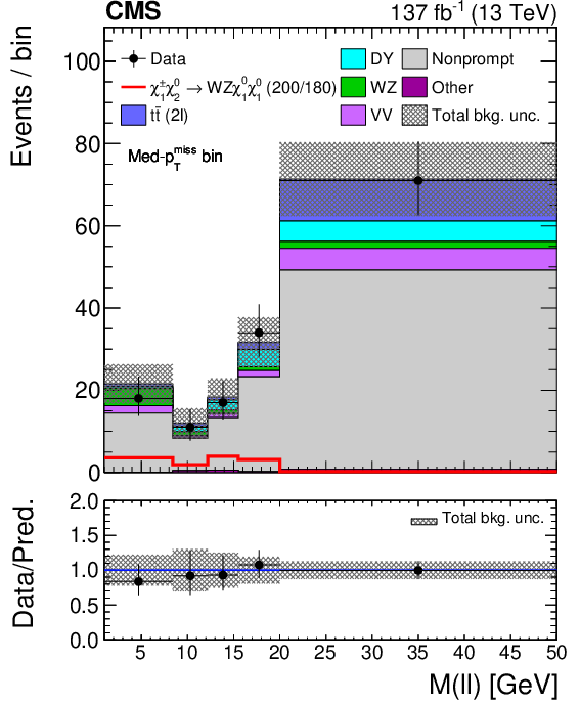
png pdf |
Figure 6-b:
``2/3$\ell $ soft'' search: post-fit distribution of the $ \text{M}(\ell\ell) $ variable for the medium- $ p_{\mathrm{T}}^\text{miss} $ bin in the ``2$ \ell $ soft'' signal region of Ref. [72]. The distribution is based on the parametric binnings derived for signal mass points with $ \Delta m = $ 20 GeV. The pre-fit signal distribution for $ m_{\tilde{\chi}_{1}^{\pm}} = m_{\tilde{\chi}_{2}^{0}}=$ 200 GeV, $m_{\tilde{\chi}^{0}}= $ 180 GeV is overlaid for illustration. ``Nonprompt'' refers to the background contribution arising from nonprompt or misidentified leptons. |
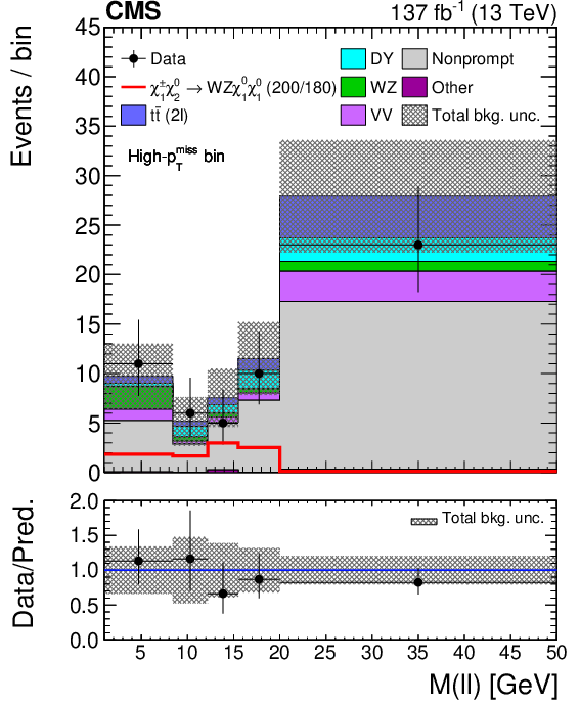
png pdf |
Figure 6-c:
``2/3$\ell $ soft'' search: post-fit distribution of the $ \text{M}(\ell\ell) $ variable for the high-$ p_{\mathrm{T}}^\text{miss} $ bin in the ``2$ \ell $ soft'' signal region of Ref. [72]. The distribution is based on the parametric binnings derived for signal mass points with $ \Delta m = $ 20 GeV. The pre-fit signal distribution for $ m_{\tilde{\chi}_{1}^{\pm}} = m_{\tilde{\chi}_{2}^{0}}=$ 200 GeV, $m_{\tilde{\chi}^{0}}= $ 180 GeV is overlaid for illustration. ``Nonprompt'' refers to the background contribution arising from nonprompt or misidentified leptons. |
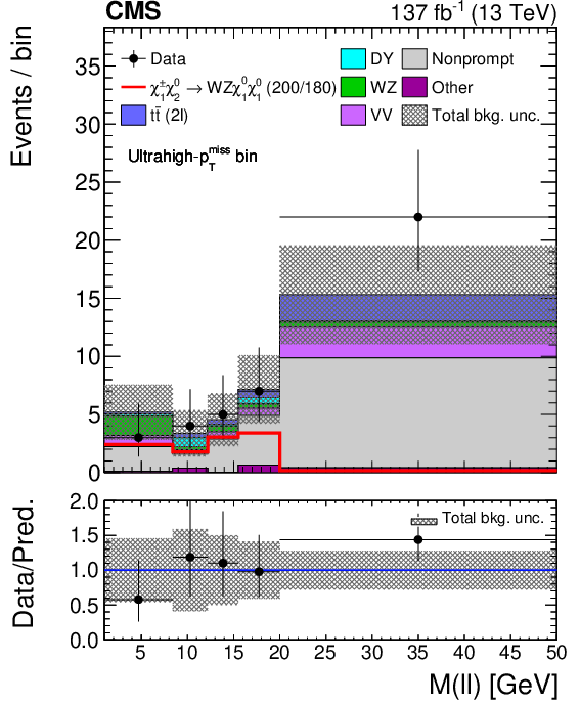
png pdf |
Figure 6-d:
``2/3$\ell $ soft'' search: post-fit distribution of the $ \text{M}(\ell\ell) $ variable for the ultrahigh-$ p_{\mathrm{T}}^\text{miss} $ bin in the ``2$ \ell $ soft'' signal region of Ref. [72]. The distribution is based on the parametric binnings derived for signal mass points with $ \Delta m = $ 20 GeV. The pre-fit signal distribution for $ m_{\tilde{\chi}_{1}^{\pm}} = m_{\tilde{\chi}_{2}^{0}}=$ 200 GeV, $m_{\tilde{\chi}^{0}}= $ 180 GeV is overlaid for illustration. ``Nonprompt'' refers to the background contribution arising from nonprompt or misidentified leptons. |
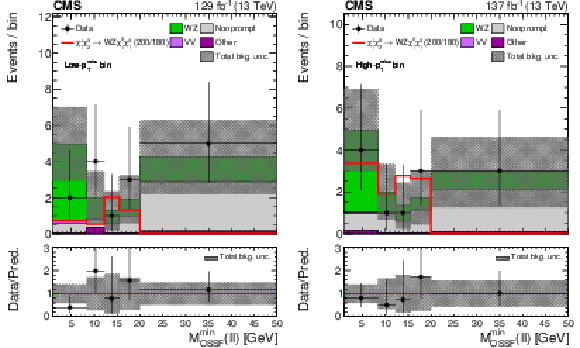
png pdf |
Figure 7:
``2/3$\ell $ soft'' search: post-fit distributions of the $ \text{M}^{\text{min}}_{\text{OSSF}}(\ell\ell) $ variable for the low- (left) and medium- (right) $ p_{\mathrm{T}}^\text{miss} $ bins in the ``3$ \ell $ soft'' signal region of Ref. [72]. These distributions are based on the parametric binnings derived for signal mass points with $ \Delta m = $ 20 GeV. The pre-fit signal distribution for $ m_{\tilde{\chi}_{1}^{\pm}} = m_{\tilde{\chi}_{2}^{0}}=$ 200 GeV, $ m_{\tilde{\chi}^{0}}= $ 180 GeV is overlaid for illustration. ``Nonprompt'' refers to the background contribution arising from nonprompt or misidentified leptons. |
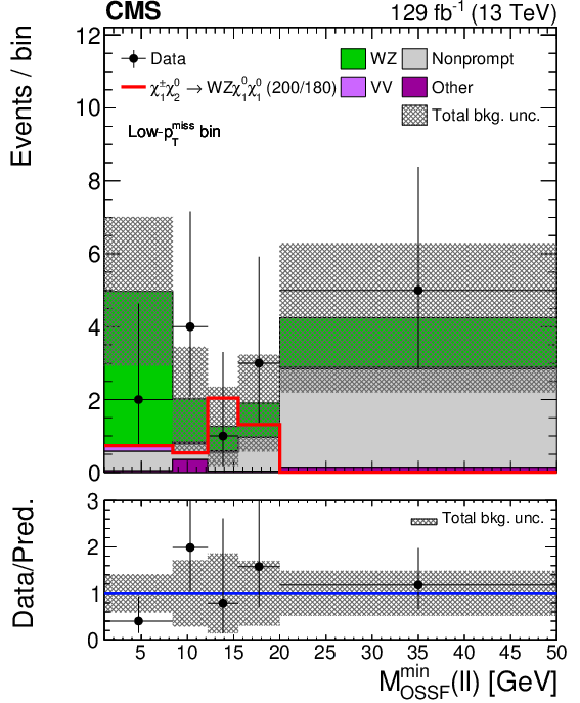
png pdf |
Figure 7-a:
``2/3$\ell $ soft'' search: post-fit distribution of the $ \text{M}^{\text{min}}_{\text{OSSF}}(\ell\ell) $ variable for the low-$ p_{\mathrm{T}}^\text{miss} $ bins in the ``3$ \ell $ soft'' signal region of Ref. [72]. The distribution is based on the parametric binnings derived for signal mass points with $ \Delta m = $ 20 GeV. The pre-fit signal distribution for $ m_{\tilde{\chi}_{1}^{\pm}} = m_{\tilde{\chi}_{2}^{0}}=$ 200 GeV, $ m_{\tilde{\chi}^{0}}= $ 180 GeV is overlaid for illustration. ``Nonprompt'' refers to the background contribution arising from nonprompt or misidentified leptons. |
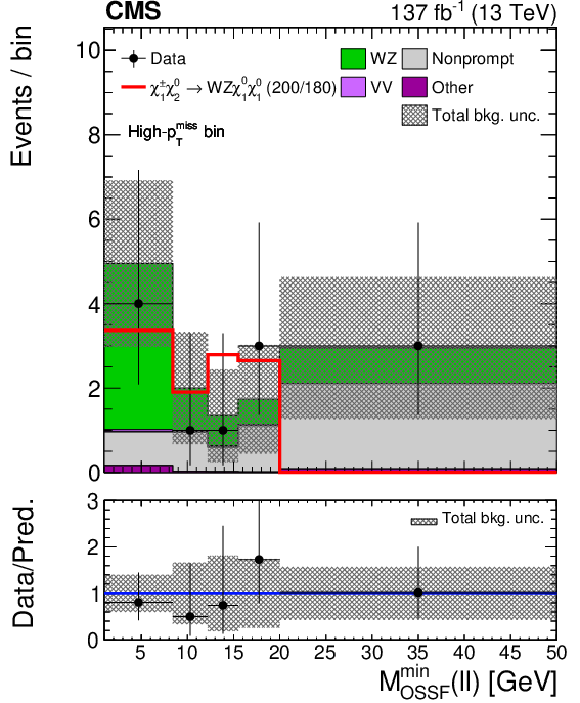
png pdf |
Figure 7-b:
``2/3$\ell $ soft'' search: post-fit distribution of the $ \text{M}^{\text{min}}_{\text{OSSF}}(\ell\ell) $ variable for the medium-$ p_{\mathrm{T}}^\text{miss} $ bins in the ``3$ \ell $ soft'' signal region of Ref. [72]. The distribution is based on the parametric binnings derived for signal mass points with $ \Delta m = $ 20 GeV. The pre-fit signal distribution for $ m_{\tilde{\chi}_{1}^{\pm}} = m_{\tilde{\chi}_{2}^{0}}=$ 200 GeV, $ m_{\tilde{\chi}^{0}}= $ 180 GeV is overlaid for illustration. ``Nonprompt'' refers to the background contribution arising from nonprompt or misidentified leptons. |

png pdf |
Figure 8:
``2/3$\ell $ soft'' search: post-fit distributions of the $ m_{\mathrm{T2}}(\ell, \ell, \chi_{100}) $ variable are shown for the low- (upper left), medium- (upper right), high- (lower left), and ultrahigh- (lower right) $ p_{\mathrm{T}}^\text{miss} $ bins in the ``2$ \ell $ soft'' signal region of Ref. [72]. These distributions are based on the parametric binnings derived for the mass-point $ m_{\tilde{\ell} }=$ 125 GeV, $ m_{\tilde{\chi}^{0}}= $ 115 GeV, for which the pre-fit signal distribution is overlaid for illustration. Note that the signal distribution (purple line) is approximately flat across $ m_{\mathrm{T2}}(\ell, \ell, \chi_{100}) $, by construction of the parametric binning procedure. The minimum value of $ m_{\mathrm{T2}}(\ell, \ell, \chi_{100}) $, $ m_\chi = $ 100 GeV, is subtracted for the abscissa of the plot. ``Nonprompt'' refers to the background contribution arising from nonprompt or misidentified leptons. |
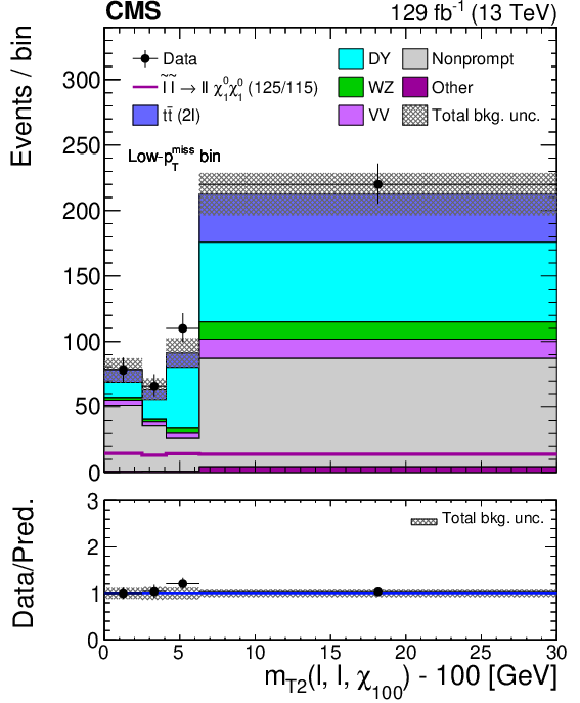
png pdf |
Figure 8-a:
``2/3$\ell $ soft'' search: post-fit distribution of the $ m_{\mathrm{T2}}(\ell, \ell, \chi_{100}) $ variable are shown for the low-$ p_{\mathrm{T}}^\text{miss} $ bin in the ``2$ \ell $ soft'' signal region of Ref. [72]. The distribution is based on the parametric binnings derived for the mass-point $ m_{\tilde{\ell} }=$ 125 GeV, $ m_{\tilde{\chi}^{0}}= $ 115 GeV, for which the pre-fit signal distribution is overlaid for illustration. Note that the signal distribution (purple line) is approximately flat across $ m_{\mathrm{T2}}(\ell, \ell, \chi_{100}) $, by construction of the parametric binning procedure. The minimum value of $ m_{\mathrm{T2}}(\ell, \ell, \chi_{100}) $, $ m_\chi = $ 100 GeV, is subtracted for the abscissa of the plot. ``Nonprompt'' refers to the background contribution arising from nonprompt or misidentified leptons. |
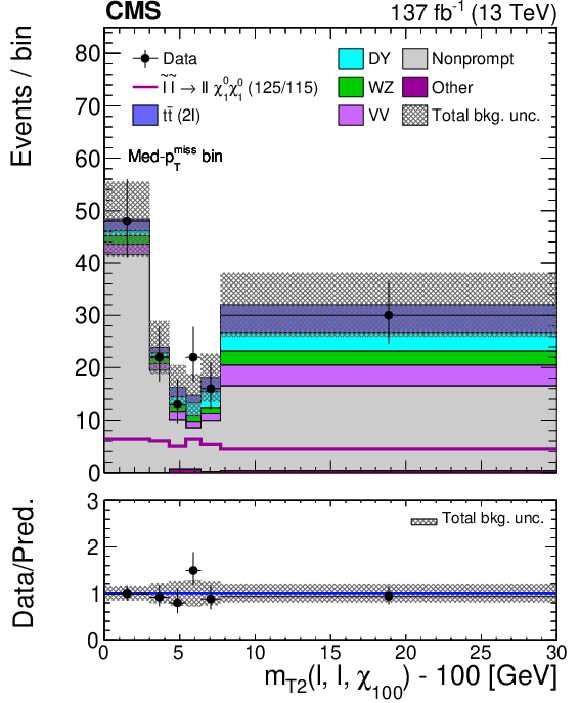
png pdf |
Figure 8-b:
``2/3$\ell $ soft'' search: post-fit distribution of the $ m_{\mathrm{T2}}(\ell, \ell, \chi_{100}) $ variable are shown for the medium-$ p_{\mathrm{T}}^\text{miss} $ bin in the ``2$ \ell $ soft'' signal region of Ref. [72]. The distribution is based on the parametric binnings derived for the mass-point $ m_{\tilde{\ell} }=$ 125 GeV, $ m_{\tilde{\chi}^{0}}= $ 115 GeV, for which the pre-fit signal distribution is overlaid for illustration. Note that the signal distribution (purple line) is approximately flat across $ m_{\mathrm{T2}}(\ell, \ell, \chi_{100}) $, by construction of the parametric binning procedure. The minimum value of $ m_{\mathrm{T2}}(\ell, \ell, \chi_{100}) $, $ m_\chi = $ 100 GeV, is subtracted for the abscissa of the plot. ``Nonprompt'' refers to the background contribution arising from nonprompt or misidentified leptons. |

png pdf |
Figure 8-c:
``2/3$\ell $ soft'' search: post-fit distribution of the $ m_{\mathrm{T2}}(\ell, \ell, \chi_{100}) $ variable are shown for the high-$ p_{\mathrm{T}}^\text{miss} $ bin in the ``2$ \ell $ soft'' signal region of Ref. [72]. The distribution is based on the parametric binnings derived for the mass-point $ m_{\tilde{\ell} }=$ 125 GeV, $ m_{\tilde{\chi}^{0}}= $ 115 GeV, for which the pre-fit signal distribution is overlaid for illustration. Note that the signal distribution (purple line) is approximately flat across $ m_{\mathrm{T2}}(\ell, \ell, \chi_{100}) $, by construction of the parametric binning procedure. The minimum value of $ m_{\mathrm{T2}}(\ell, \ell, \chi_{100}) $, $ m_\chi = $ 100 GeV, is subtracted for the abscissa of the plot. ``Nonprompt'' refers to the background contribution arising from nonprompt or misidentified leptons. |
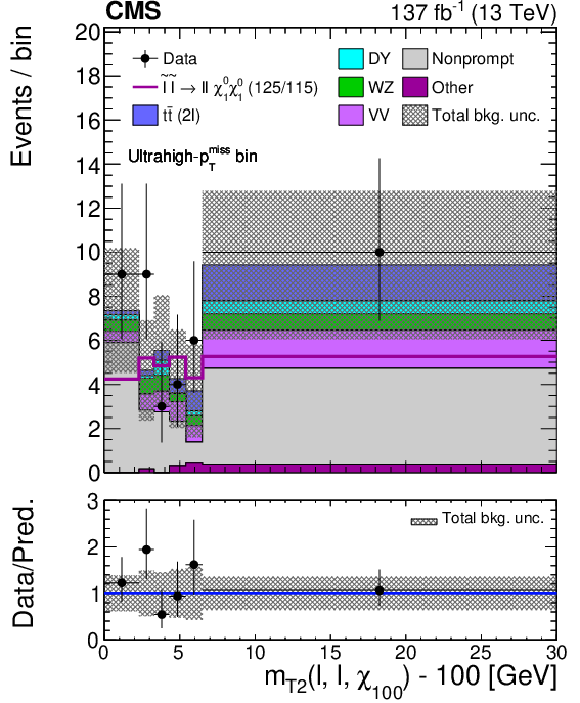
png pdf |
Figure 8-d:
``2/3$\ell $ soft'' search: post-fit distribution of the $ m_{\mathrm{T2}}(\ell, \ell, \chi_{100}) $ variable are shown for the ultrahigh-$ p_{\mathrm{T}}^\text{miss} $ bin in the ``2$ \ell $ soft'' signal region of Ref. [72]. The distribution is based on the parametric binnings derived for the mass-point $ m_{\tilde{\ell} }=$ 125 GeV, $ m_{\tilde{\chi}^{0}}= $ 115 GeV, for which the pre-fit signal distribution is overlaid for illustration. Note that the signal distribution (purple line) is approximately flat across $ m_{\mathrm{T2}}(\ell, \ell, \chi_{100}) $, by construction of the parametric binning procedure. The minimum value of $ m_{\mathrm{T2}}(\ell, \ell, \chi_{100}) $, $ m_\chi = $ 100 GeV, is subtracted for the abscissa of the plot. ``Nonprompt'' refers to the background contribution arising from nonprompt or misidentified leptons. |

png pdf |
Figure 9:
``2SS$ \ell/{\geq}\,3\ell $" search: observed and expected event yields across the SRs in category A, events with three light leptons of which at least two form an OSSF pair, after the requirement that the leading-lepton $ p_{\mathrm{T}} $ be greater than 30 GeV is applied. The pre-fit signal distributions for three mass-points are overlaid for illustration, and the considered mass hypothesis is indicated in the legend with notation $ (m $ (NLSP) $ /m $ (LSP) $) $; for example (150/1) stands for $ m_{\tilde{\chi}_{1}^{\pm}} = m_{\tilde{\chi}_{2}^{0}}=$ 150 GeV, $m_{\tilde{\chi}^{0}}= $ 1 GeV. ``Nonprompt'' refers to the background contribution arising from nonprompt or misidentified leptons. |
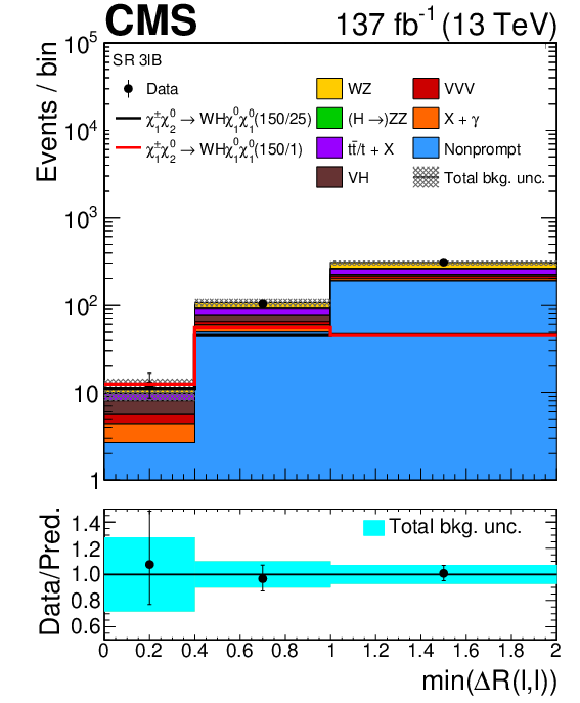
png pdf |
Figure 10:
``2SS$ \ell/{\geq}\,3\ell $" search: observed and expected event yields across the SRs in category B, events with three light leptons and no OSSF pair, after the requirement that the leading-lepton $ p_{\mathrm{T}} $ be greater than 30 GeV is applied. The pre-fit signal distributions for two mass-points are overlaid for illustration, and the considered mass hypothesis is indicated in the legend with notation $ (m $ (NLSP) $ /m $ (LSP) $) $; for example (150/1) stands for $ m_{\tilde{\chi}_{1}^{\pm}} = m_{\tilde{\chi}_{2}^{0}}= $ 150 GeV, $ m_{\tilde{\chi}^{0}}= $ 1 GeV. ``Nonprompt'' refers to the background contribution arising from nonprompt or misidentified leptons. |

png pdf |
Figure 11:
Wino-bino model: cross section limits with expected and observed exclusion boundaries in the model parameter space in the WZ topology for the full parameter space (upper left) as well as the compressed region (upper right), the WH topology (lower left), and the mixed topology with 50% branching fraction to WZ and WH (lower right). All masses below the contours are excluded, except in the case of the upper-right plot where the area on the left of the contour is excluded. For some signal regions the analysis was based on a subset of the data, corresponding to the integrated luminosity of 129 fb$ ^{-1} $. |

png pdf |
Figure 11-a:
Wino-bino model: cross section limits with expected and observed exclusion boundaries in the model parameter space in the WZ topology for the full parameter space. All masses below the contours are excluded. For the signal region the analysis was based on a subset of the data, corresponding to the integrated luminosity of 129 fb$ ^{-1} $. |
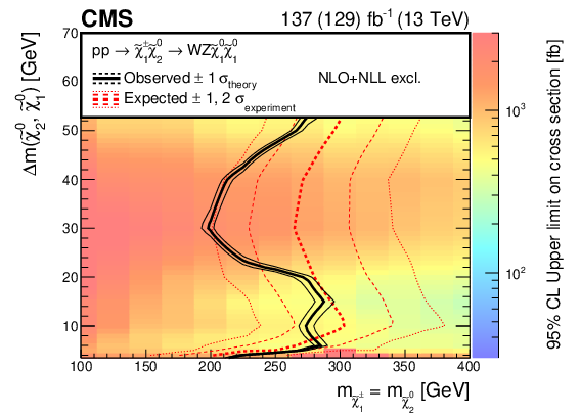
png pdf |
Figure 11-b:
Wino-bino model: cross section limits with expected and observed exclusion boundaries in the model parameter space in the WZ topology for the compressed region. The area on the left of the contour is excluded. For the signal region the analysis was based on a subset of the data, corresponding to the integrated luminosity of 129 fb$ ^{-1} $. |

png pdf |
Figure 11-c:
Wino-bino model: cross section limits with expected and observed exclusion boundaries in the model parameter space in the WZ topology for the WH topology. All masses below the contours are excluded. |
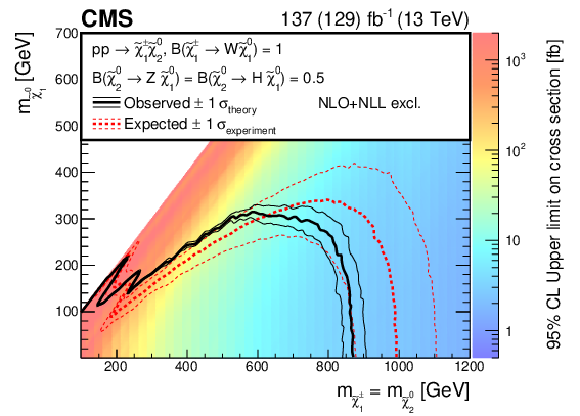
png pdf |
Figure 11-d:
Wino-bino model: cross section limits with expected and observed exclusion boundaries in the model parameter space in the WZ topology for the mixed topology with 50% branching fraction to WZ and WH. All masses below the contours are excluded. For the signal region the analysis was based on a subset of the data, corresponding to the integrated luminosity of 129 fb$ ^{-1} $. |
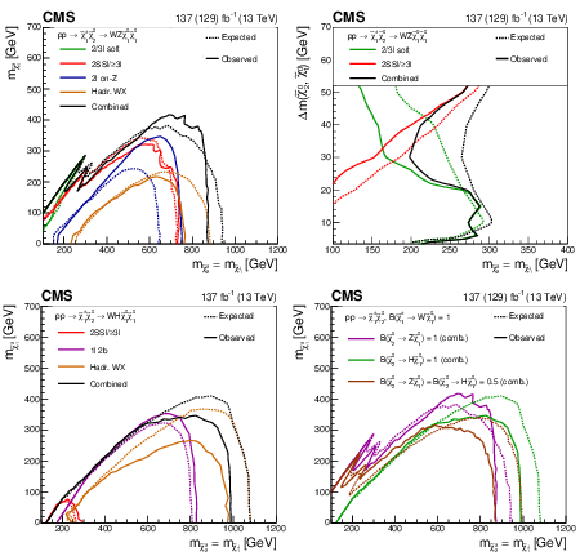
png pdf |
Figure 12:
Wino-bino model: exclusion contours from the individual analyses targeting the WZ topology for the full parameter space (upper left), the corresponding compressed region (upper right), and the WH topology (lower left). The combined contours for these two topologies are also shown. The combined contours for these and the mixed topology are overlaid in the lower-right plot. The decay modes assumed for each contour are given in the legends. All masses below the contours are excluded, except in the case of the upper-right plot where the area on the left of the contour is excluded. For some signal regions the analysis was based on a subset of the data, corresponding to the integrated luminosity of 129 fb$ ^{-1} $. |
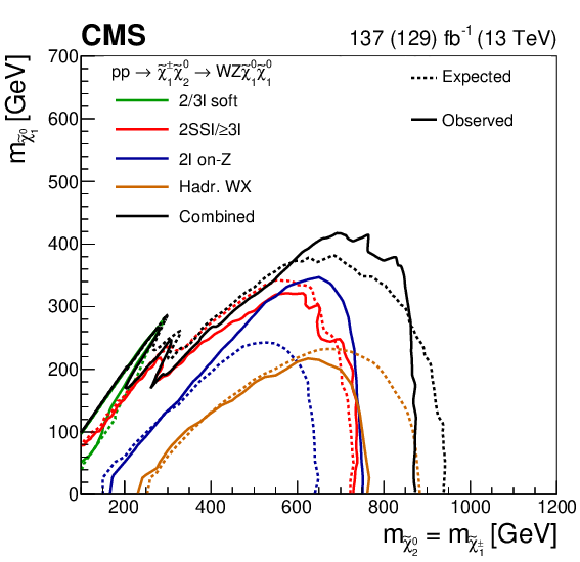
png pdf |
Figure 12-a:
Wino-bino model: exclusion contours from the individual analyses targeting the WZ topology for the full parameter space. All masses below the contours are excluded. For some signal regions the analysis was based on a subset of the data, corresponding to the integrated luminosity of 129 fb$ ^{-1} $. |
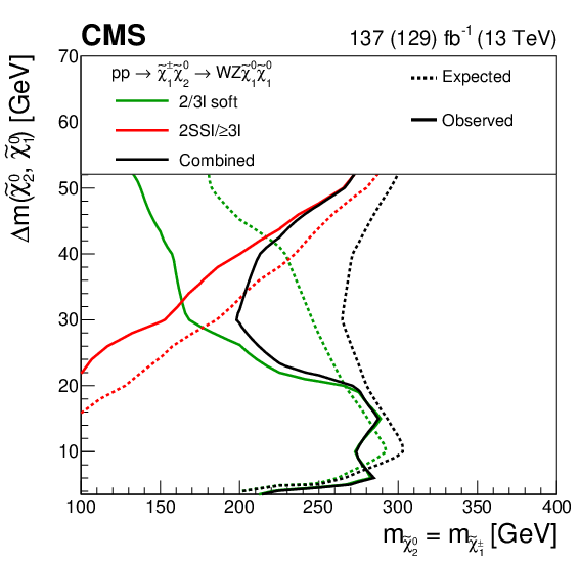
png pdf |
Figure 12-b:
Wino-bino model: exclusion contours from the individual analyses targeting the WZ topology for the compressed region. The combined contour is also shown. The area on the left of the contour is excluded. For some signal regions the analysis was based on a subset of the data, corresponding to the integrated luminosity of 129 fb$ ^{-1} $. |
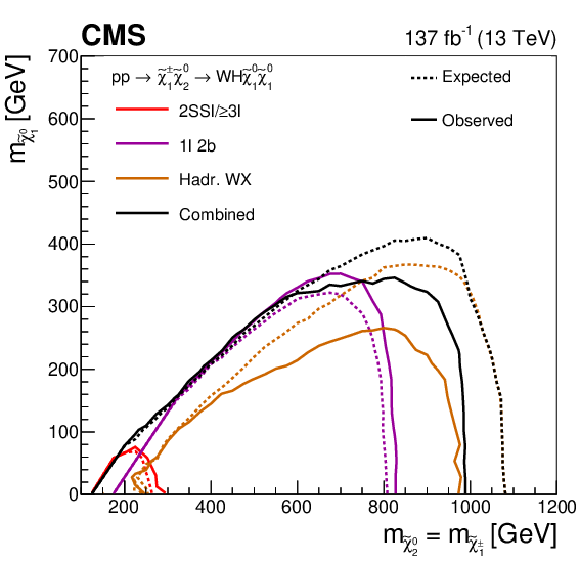
png pdf |
Figure 12-c:
Wino-bino model: exclusion contours from the individual analyses targeting the WZ topology for the WH topology. The combined contour is also shown. All masses below the contours are excluded. |

png pdf |
Figure 12-d:
Wino-bino model: combined exclusion contours for the WZ/WH topologies. The decay modes assumed for each contour are given in the legends. All masses below the contours are excluded. For some signal regions the analysis was based on a subset of the data, corresponding to the integrated luminosity of 129 fb$ ^{-1} $. |
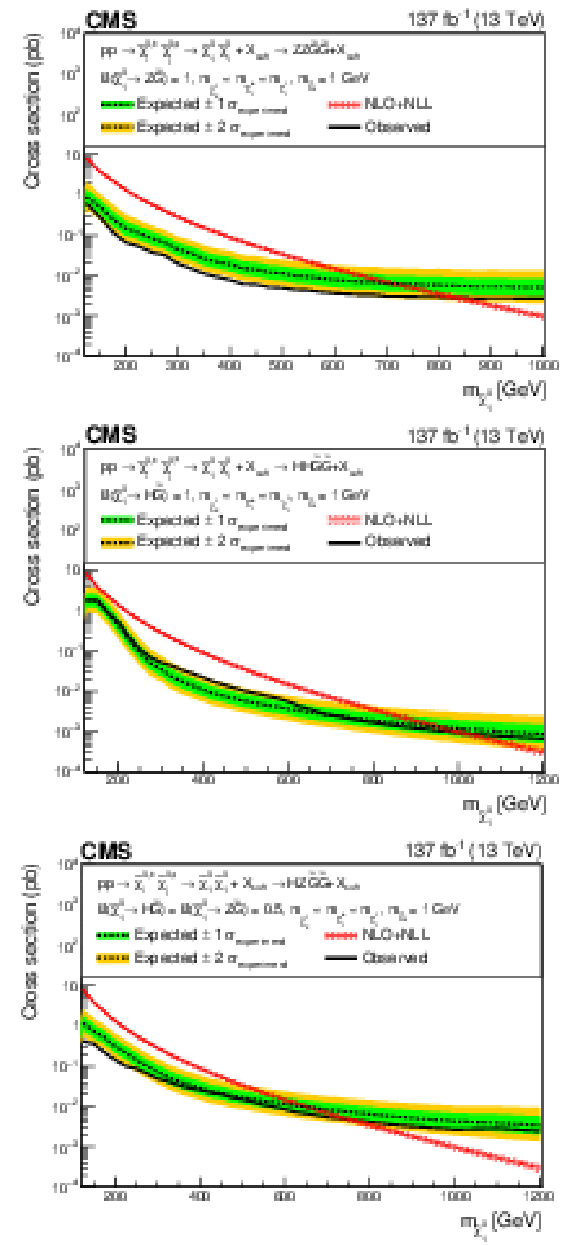
png pdf |
Figure 13:
GMSB model: expected and observed exclusion limits for the ZZ topology (upper), the HH topology (middle), and the mixed topology with 50% branching fraction to H and Z (lower). All masses on the left of the crossing between the exclusion limits and theory prediction are excluded. |
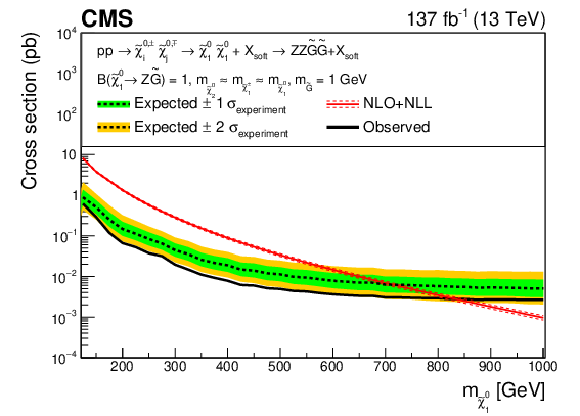
png pdf |
Figure 13-a:
GMSB model: expected and observed exclusion limits for the ZZ topology. All masses on the left of the crossing between the exclusion limits and theory prediction are excluded. |

png pdf |
Figure 13-b:
GMSB model: expected and observed exclusion limits for the HH topology. All masses on the left of the crossing between the exclusion limits and theory prediction are excluded. |

png pdf |
Figure 13-c:
GMSB model: expected and observed exclusion limits for the mixed topology with 50% branching fraction to H and Z. All masses on the left of the crossing between the exclusion limits and theory prediction are excluded. |

png pdf |
Figure 14:
GMSB model: NLSP mass exclusion limit as a function of the branching fraction to the H boson. Left: expected and observed limits for the combination of the searches, shown together with the observed limits of the combination [52] based on the 2016 CMS data. Right: expected and observed exclusion limits for the combination in comparison with those of the input searches. All masses on the left of the contours are excluded. |

png pdf |
Figure 14-a:
GMSB model: NLSP mass exclusion limit as a function of the branching fraction to the H boson. Expected and observed limits for the combination of the searches, shown together with the observed limits of the combination [52] based on the 2016 CMS data. |
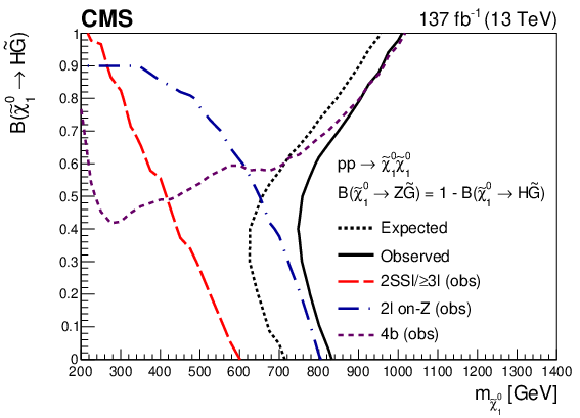
png pdf |
Figure 14-b:
GMSB model: NLSP mass exclusion limit as a function of the branching fraction to the H boson. Expected and observed exclusion limits for the combination in comparison with those of the input searches. All masses on the left of the contours are excluded. |

png pdf |
Figure 15:
Higgsino-bino model: cross section upper limit in the mass plane of the model, and the expected and observed exclusion limits. The model assumes mass-degenerate higgsino-like $ \tilde{\chi}_{2}^{0} $, $ \tilde{\chi}_{3}^{0} $, and $ \tilde{\chi}_{1}^{\pm} $ that decay to a bino-like $ \tilde{\chi}_{1}^{0} $ and an SM boson. All masses below the contours are excluded. |
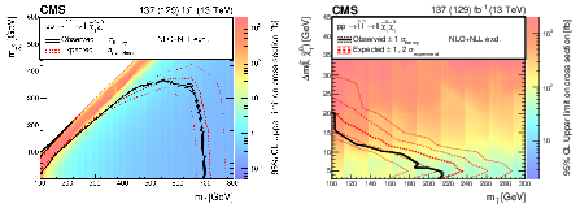
png pdf |
Figure 16:
Slepton-neutralino model: mass plane cross section upper limit with observed and expected exclusion limits. Left: the full mass plane from the combination. Right: the compressed region, obtained by the ``2/3$\ell $ soft'' search. For some signal regions the analysis was based on a subset of the data, corresponding to the integrated luminosity of 129 fb$ ^{-1} $. All masses below the contours are excluded, except in the case of the right figure where the area on the left of the contour is excluded. |

png |
Figure 16-a:
Slepton-neutralino model: mass plane cross section upper limit with observed and expected exclusion limits. The full mass plane from the combination. For some signal regions the analysis was based on a subset of the data, corresponding to the integrated luminosity of 129 fb$ ^{-1} $. All masses below the contour are excluded. |
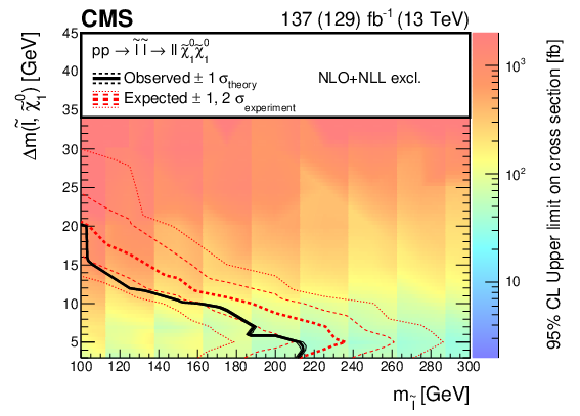
png pdf |
Figure 16-b:
Slepton-neutralino model: mass plane cross section upper limit with observed and expected exclusion limits. The compressed region, obtained by the ``2/3$\ell $ soft'' search. For some signal regions the analysis was based on a subset of the data, corresponding to the integrated luminosity of 129 fb$ ^{-1} $. The area on the left of the contour is excluded. |
| Tables | |

png pdf |
Table 1:
``2/3$\ell $ soft'' search: definition of the lepton multiplicity and $ p_{\mathrm{T}}^\text{miss, corr} $ SRs. The boundaries are indicated in GeVns. Events in the low-$ p_{\mathrm{T}}^\text{miss} $ SR must additionally have $ p_{\mathrm{T}}^\text{miss} > $ 125 GeV. |

png pdf |
Table 2:
Summary of the searches considered in the combination and the SRs that contribute to the interpretation of each signal model and topology. The following abbreviations appear in the table: For the ``2$ \ell $ on-Z'' analysis, ``EW'' refers to the resolved and boosted VZ SRs and the HZ SR. The row label ``2$ \ell $ nonres.''\ refers to the ``2$ \ell $ nonresonant'' search, and in that row ``Slepton'' refers to the two dedicated slepton SRs, those requiring $ N_{\text{jet}}= $ 0 and $ N_{\text{jet}} > $ 0. For the ``2SS$ \ell/{\geq}\,3\ell $" search, ``A(NN)'' indicates SR A with the parametric neural network signal extraction. For the "Hadr. WX'', ``ex H'' means all SRs except the b-tag H SR. |
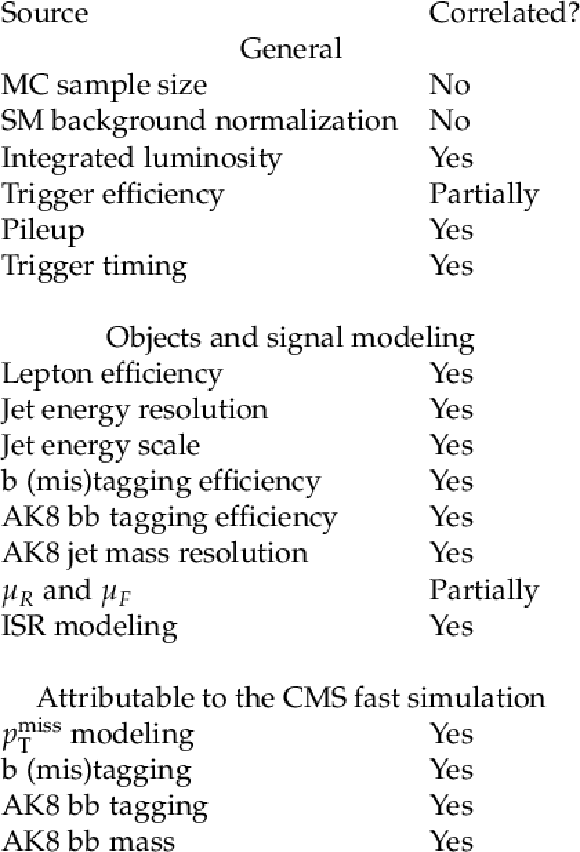
png pdf |
Table 3:
Sources of systematic uncertainties and the treatment of their correlations between analyses. Exceptions to the notations in the last column are: for the ``SM background normalization'' row, the WZ normalization is correlated between the ``2SS$ \ell/{\geq}\,3\ell $" [73] and ``2/3$\ell $ soft'' [72] searches, and for the ``Lepton efficiency'' row the two contributing searches, ``2/3$\ell $ soft'' [72] and ``2$ \ell $ nonresonant'' [70], are uncorrelated because they cover disjoint regions of the model parameter space. |
| Summary |
| A number of previously reported searches for supersymmetry (SUSY) in different final states from proton-proton collisions at $ \sqrt{s}= $ 13 TeV have been reoptimized and combined. The data were recorded with the CMS detector at the LHC and correspond to an integrated luminosity of up to 137 fb$ ^{-1} $. These data are used to test the predictions of a variety of simplified SUSY models that involve the electroweak production of the superpartners of electroweak gauge or Higgs bosons. No significant deviation from the standard model expectation has been observed, and limits are set on the production of wino-like chargino-neutralino pairs, higgsino-like neutralino pair production in a gauge-mediated SUSY breaking inspired scenario, a higgsino-bino interpretation, and slepton pair production. In the case of wino-like chargino-neutralino production, for a $ \tilde{\chi}_{1}^{0} $, the lightest SUSY particle in this model, with mass $ m_{\tilde{\chi}_{1}^{\pm}} < $ 50 GeV, the combined result gives an observed (expected) limit on $ m_{\tilde{\chi}_{1}^{\pm}} $ of about 875 (950) GeV for the WZ topology, 990 (1075) GeV for the WH topology, and 875 (1000) GeV for a mixed topology, extending the previous CMS combination [52] (based on a 2016 data set corresponding to 36 fb$^{-1}$), by 225, 510, and 340 GeV, respectively, for the three topologies. For higgsino-like neutralino pair production, the mass exclusion limit is a function of the branching ratio between the H and Z channels; the expected limit ranges between about 620 and 950 GeV, the smaller value occurring for $ \mathcal{B}(\tilde{\chi}_{1}^{0} \to \mathrm{H}\tilde{\mathrm{G}}) \approx $ 0.4. For this value of the branching fraction, the observed limit results in the exclusion of masses below 750 GeV, and extends the previous result [52] by 100 GeV. The observed limit reaches nearly 1025 GeV at $ \mathcal{B}(\tilde{\chi}_{1}^{0} \to \mathrm{H}\tilde{\mathrm{G}}) = $ 1, to be compared with 750 GeV reported in Ref. [52]. A higgsino-bino model that assumes mass degenerate higgsino-like $ \tilde{\chi}_{2}^{0} $, $ \tilde{\chi}_{3}^{0} $, and $ \tilde{\chi}_{1}^{\pm} $ decaying to a bino-like $ \tilde{\chi}_{1}^{0} $ and a standard model boson is excluded for $ m_{\tilde{\chi}_{1}^{\pm}}=m_{\tilde{\chi}_{2}^{0}} $ between 225 and 800 GeV for $ m_{\tilde{\chi}_{1}^{0}} < $ 50 GeV. For direct production of the superpartners of electrons and muons (sleptons), this combined search yields an observed (expected) exclusion in the slepton mass of about 130-700 (110-720) GeV, for $ m_{\tilde{\chi}_{1}^{0}} < $ 50 GeV. In the compressed-spectrum region, a dedicated search first reported here excludes slepton masses above 215 GeV for a 5 GeV difference between the slepton and $ \tilde{\chi}_{1}^{0} $ masses. In general for the models considered in this combination, wino-like chargino masses are excluded up to 990 GeV, while higgsino-like neutralino masses are excluded up to 1025 GeV. The improvement is between 100-510 GeV with respect to the previous exclusion limits [52], whereas the excluded model parameter space is expanded by as much as 125 GeV, depending on the model, with respect to the best of the component searches. The compressed parameter space of the slepton production model is explored here for the first time by CMS. |
| Additional Figures | |

png pdf |
Additional Figure 1:
Wino-bino model: exclusion contours from the ``2$/$3$\ell $ soft'' analysis targeting the WZ topology, obtained with the static and parametric binnings, and assuming a flat phase space for the $ \tilde{\chi}_{2}^{0} $ decay rate. The former binning was used in the original search together with a corrected dilepton mass spectra. The latter binning is used for this combination, and the flat phase space decay rate is applied to ensure consistency among the input analyses. The area to the left of the contour is excluded. For some signal regions the analysis was based on a subset of the data, corresponding to the integrated luminosity of 129 fb$^{-1}$. |

png pdf |
Additional Figure 2:
Wino-bino model: The analysis with the best exclusion limit for each point in the plane for the WZ topology (upper left), the WH topology (upper right), and the mixed topology with 50% branching fraction to WZ and WH (bottom). For some signal regions the analysis was based on a subset of the data, corresponding to the integrated luminosity of 129 fb$^{-1}$. |
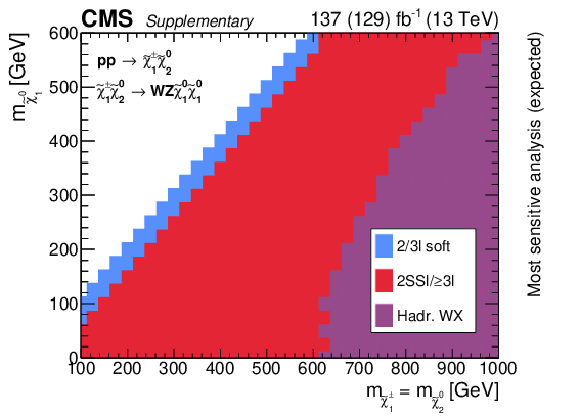
png pdf |
Additional Figure 2-a:
Wino-bino model: The analysis with the best exclusion limit for each point in the plane for the WZ topology. For some signal regions the analysis was based on a subset of the data, corresponding to the integrated luminosity of 129 fb$^{-1}$. |
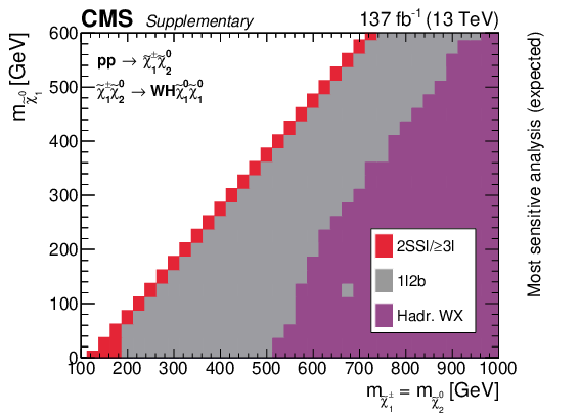
png pdf |
Additional Figure 2-b:
Wino-bino model: The analysis with the best exclusion limit for each point in the plane for the WH topology. For some signal regions the analysis was based on a subset of the data, corresponding to the integrated luminosity of 129 fb$^{-1}$. |
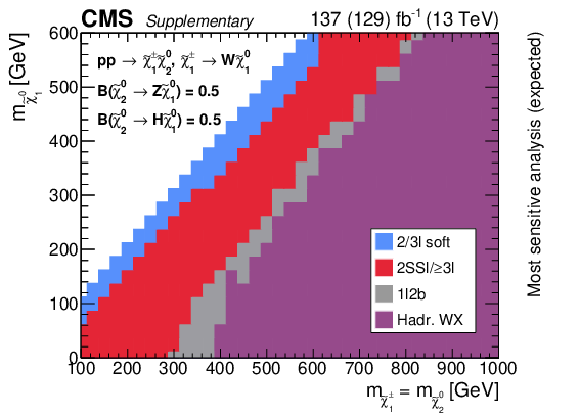
png pdf |
Additional Figure 2-c:
Wino-bino model: The analysis with the best exclusion limit for each point in the plane for the mixed topology with 50% branching fraction to WZ and WH. For some signal regions the analysis was based on a subset of the data, corresponding to the integrated luminosity of 129 fb$^{-1}$. |
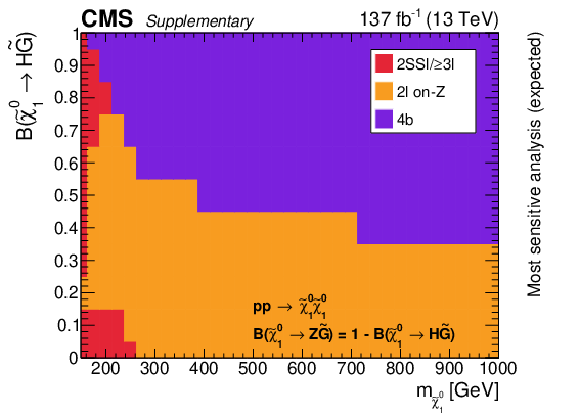
png pdf |
Additional Figure 3:
GMSB model: The analysis with the best exclusion limit for each point in the branching fraction-$ m_{\tilde{\chi}_{1}^{0}} $ plane. |
| References | ||||
| 1 | J. Wess and B. Zumino | Supergauge transformations in four dimensions | NPB 70 (1974) 39 | |
| 2 | H. P. Nilles | Supersymmetry, supergravity and particle physics | Phys. Rep. 110 (1984) 1 | |
| 3 | H. E. Haber and G. L. Kane | The search for supersymmetry: Probing physics beyond the standard model | Phys. Rept. 117 (1985) 75 | |
| 4 | R. Barbieri, S. Ferrara, and C. A. Savoy | Gauge models with spontaneously broken local supersymmetry | PLB 119 (1982) 343 | |
| 5 | S. Dawson, E. Eichten, and C. Quigg | Search for supersymmetric particles in hadron-hadron collisions | PRD 31 (1985) 1581 | |
| 6 | S. Dimopoulos and G. F. Giudice | Naturalness constraints in supersymmetric theories with nonuniversal soft terms | PLB 357 (1995) 573 | hep-ph/9507282 |
| 7 | R. Barbieri and D. Pappadopulo | S-particles at their naturalness limits | JHEP 10 (2009) 061 | 0906.4546 |
| 8 | M. Papucci, J. T. Ruderman, and A. Weiler | Natural SUSY endures | JHEP 09 (2012) 035 | 1110.6926 |
| 9 | A. J. Buras, J. Ellis, M. K. Gaillard, and D. V. Nanopoulos | Aspects of the grand unification of strong, weak and electromagnetic interactions | NPB 135 (1978) 66 | |
| 10 | G. R. Farrar and P. Fayet | Phenomenology of the production, decay, and detection of new hadronic states associated with supersymmetry | PLB 76 (1978) 575 | |
| 11 | H. Goldberg | Constraint on the photino mass from cosmology | PRL 50 (1983) 1419 | |
| 12 | J. R. Ellis et al. | Supersymmetric relics from the big bang | NPB 238 (1984) 453 | |
| 13 | P. Fayet and S. Ferrara | Supersymmetry | Phys. Rept. 32 (1977) 249 | |
| 14 | S. P. Martin | A supersymmetry primer | Adv. Ser. Direct. High Energy Phys. 21 (2010) 1 | hep-ph/9709356 |
| 15 | S. Dimopoulos, M. Dine, S. Raby, and S. D. Thomas | Experimental signatures of low-energy gauge mediated supersymmetry breaking | PRL 76 (1996) 3494 | hep-ph/9601367 |
| 16 | K. T. Matchev and S. D. Thomas | Higgs and $ Z $ boson signatures of supersymmetry | PRD 62 (2000) 077702 | hep-ph/9908482 |
| 17 | ATLAS Collaboration | Search for supersymmetry in events with photons, bottom quarks, and missing transverse momentum in proton-proton collisions at a centre-of-mass energy of 7 TeV with the ATLAS detector | PLB 719 (2013) 261 | 1211.1167 |
| 18 | ATLAS Collaboration | Search for direct pair production of a chargino and a neutralino decaying to the 125 GeV Higgs boson in $ \sqrt{s} = $ 8 TeV $ pp$ collisions with the ATLAS detector | EPJC 75 (2015) 208 | 1501.07110 |
| 19 | ATLAS Collaboration | Search for the electroweak production of supersymmetric particles in $ \sqrt{s} =$ 8 TeV $pp$ collisions with the ATLAS detector | PRD 93 (2016) 052002 | 1509.07152 |
| 20 | ATLAS Collaboration | Search for supersymmetry in final states with two same-sign or three leptons and jets using 36 fb$ ^{-1} $ of $ \sqrt{s}= $ 13 TeV $ pp $ collision data with the ATLAS detector | JHEP 09 (2017) 084 | 1706.03731 |
| 21 | ATLAS Collaboration | Search for new phenomena with large jet multiplicities and missing transverse momentum using large-radius jets and flavour-tagging at ATLAS in 13 TeV $ pp $ collisions | JHEP 12 (2017) 034 | 1708.02794 |
| 22 | ATLAS Collaboration | Search for the direct production of charginos and neutralinos in final states with tau leptons in $ \sqrt{s} = $ 13 TeV $ pp $ collisions with the ATLAS detector | EPJC 78 (2018) 154 | 1708.07875 |
| 23 | ATLAS Collaboration | Search for electroweak production of supersymmetric states in scenarios with compressed mass spectra at $ \sqrt{s}= $ 13 TeV with the ATLAS detector | PRD 97 (2018) 052010 | 1712.08119 |
| 24 | ATLAS Collaboration | Search for photonic signatures of gauge-mediated supersymmetry in 13 TeV $ pp $ collisions with the ATLAS detector | PRD 97 (2018) 092006 | 1802.03158 |
| 25 | ATLAS Collaboration | Search for supersymmetry in events with four or more leptons in $ \sqrt{s}= $ 13 TeV $ pp $ collisions with ATLAS | PRD 98 (2018) 032009 | 1804.03602 |
| 26 | ATLAS Collaboration | Search for electroweak production of supersymmetric particles in final states with two or three leptons at $ \sqrt{s}= $ 13 TeV with the ATLAS detector | EPJC 78 (2018) 995 | 1803.02762 |
| 27 | ATLAS Collaboration | Search for chargino-neutralino production using recursive jigsaw reconstruction in final states with two or three charged leptons in proton-proton collisions at $ \sqrt{s}= $ 13 TeV with the ATLAS detector | PRD 98 (2018) 092012 | 1806.02293 |
| 28 | ATLAS Collaboration | Search for pair production of higgsinos in final states with at least three $ b $-tagged jets in $ \sqrt{s} = $ 13 TeV pp collisions using the ATLAS detector | PRD 98 (2018) 092002 | 1806.04030 |
| 29 | ATLAS Collaboration | Search for chargino and neutralino production in final states with a Higgs boson and missing transverse momentum at $ \sqrt{s} = $ 13 TeV with the ATLAS detector | PRD 100 (2019) 012006 | 1812.09432 |
| 30 | ATLAS Collaboration | Searches for electroweak production of supersymmetric particles with compressed mass spectra in $ \sqrt{s}= $ 13 TeV $ pp $ collisions with the ATLAS detector | PRD 101 (2020) 052005 | 1911.12606 |
| 31 | ATLAS Collaboration | Search for chargino-neutralino production with mass splittings near the electroweak scale in three-lepton final states in $ \sqrt {s} = $ 13 TeV pp collisions with the ATLAS detector | PRD 101 (2020) 072001 | 1912.08479 |
| 32 | ATLAS Collaboration | Search for direct production of electroweakinos in final states with missing transverse momentum and a Higgs boson decaying into photons in pp collisions at $ \sqrt{s} = $ 13 TeV with the ATLAS detector | JHEP 10 (2020) 005 | 2004.10894 |
| 33 | ATLAS Collaboration | Search for direct production of electroweakinos in final states with one lepton, missing transverse momentum and a Higgs boson decaying into two $ b $-jets in pp collisions at $ \sqrt{s}= $ 13 TeV with the ATLAS detector | EPJC 80 (2020) 691 | 1909.09226 |
| 34 | ATLAS Collaboration | Search for direct stau production in events with two hadronic $ \tau $-leptons in $ \sqrt{s} = $ 13 TeV $ pp $ collisions with the ATLAS detector | PRD 101 (2020) 032009 | 1911.06660 |
| 35 | ATLAS Collaboration | Search for electroweak production of charginos and sleptons decaying into final states with two leptons and missing transverse momentum in $ \sqrt{s}= $ 13 TeV pp collisions using the ATLAS detector | EPJC 80 (2020) 123 | 1908.08215 |
| 36 | ATLAS Collaboration | Search for supersymmetry in events with four or more charged leptons in 139 fb$^{-1}$ of $ \sqrt{s}= $ 13 TeV pp collisions with the ATLAS detector | JHEP 07 (2021) 167 | 2103.11684 |
| 37 | ATLAS Collaboration | Search for chargino-neutralino pair production in final states with three leptons and missing transverse momentum in $ \sqrt{s} = $ 13 TeV pp collisions with the ATLAS detector | EPJC 81 (2021) 1118 | 2106.01676 |
| 38 | ATLAS Collaboration | Search for charginos and neutralinos in final states with two boosted hadronically decaying bosons and missing transverse momentum in pp collisions at $ \sqrt{s}= $ 13 TeV with the ATLAS detector | PRD 104 (2021) 112010 | 2108.07586 |
| 39 | ATLAS Collaboration | Searches for new phenomena in events with two leptons, jets, and missing transverse momentum in 139 fb$ ^{-1} $ of $ \sqrt{s}= $ 13 TeV pp collisions with the ATLAS detector | EPJC 83 (2023) 515 | 2204.13072 |
| 40 | ATLAS Collaboration | Search for direct pair production of sleptons and charginos decaying to two leptons and neutralinos with mass splittings near the W-boson mass in $ \sqrt{s}= $ 13 TeV pp collisions with the ATLAS detector | JHEP 06 (2023) 031 | 2209.13935 |
| 41 | ATLAS Collaboration | Search for direct production of winos and higgsinos in events with two same-charge leptons or three leptons in pp collision data at $ \sqrt{s}= $ 13 TeV with the ATLAS detector | JHEP 11 (2023) 150 | 2305.09322 |
| 42 | ATLAS Collaboration | Search for direct production of electroweakinos in final states with one lepton, jets and missing transverse momentum in pp collisions at $ \sqrt{s}= $ 13 TeV with the ATLAS detector | Submitted to JHEP | 2310.08171 |
| 43 | ATLAS Collaboration | Search for pair production of higgsinos in events with two Higgs bosons and missing transverse momentum in $ \sqrt{s}= $ 13 TeV pp collisions at the ATLAS experiment | Submitted to PRD | 2401.14922 |
| 44 | ATLAS Collaboration | A statistical combination of ATLAS Run 2 searches for charginos and neutralinos at the LHC | Submitted to PRL, 2024 | 2402.08347 |
| 45 | CMS Collaboration | Searches for electroweak production of charginos, neutralinos, and sleptons decaying to leptons and W, Z, and Higgs bosons in pp collisions at 8 TeV | EPJC 74 (2014) 3036 | CMS-SUS-13-006 1405.7570 |
| 46 | CMS Collaboration | Search for top squark and higgsino production using diphoton Higgs boson decays | PRL 112 (2014) 161802 | CMS-SUS-13-014 1312.3310 |
| 47 | CMS Collaboration | Searches for electroweak neutralino and chargino production in channels with Higgs, Z, and W bosons in pp collisions at 8 TeV | PRD 90 (2014) 092007 | CMS-SUS-14-002 1409.3168 |
| 48 | CMS Collaboration | Search for physics beyond the standard model in events with two leptons of same sign, missing transverse momentum, and jets in proton-proton collisions at $ \sqrt{s} = $ 13 TeV | EPJC 77 (2017) 578 | CMS-SUS-16-035 1704.07323 |
| 49 | CMS Collaboration | Search for electroweak production of charginos and neutralinos in WH events in proton-proton collisions at $ \sqrt{s}= $ 13 TeV | JHEP 11 (2017) 029 | CMS-SUS-16-043 1706.09933 |
| 50 | CMS Collaboration | Search for supersymmetry in events with at least one photon, missing transverse momentum, and large transverse event activity in proton-proton collisions at $ \sqrt{s}= $ 13 TeV | JHEP 12 (2017) 142 | CMS-SUS-16-047 1707.06193 |
| 51 | CMS Collaboration | Search for supersymmetry with Higgs boson to diphoton decays using the razor variables at $ \sqrt{s} = $ 13 TeV | PLB 779 (2018) 166 | CMS-SUS-16-045 1709.00384 |
| 52 | CMS Collaboration | Search for higgsino pair production in $ pp $ collisions at $ \sqrt{s} = $ 13 TeV in final states with large missing transverse momentum and two Higgs bosons decaying via $ H \to b \bar b $ | PRD 97 (2018) 032007 | CMS-SUS-16-044 1709.04896 |
| 53 | CMS Collaboration | Combined search for electroweak production of charginos and neutralinos in proton-proton collisions at $ \sqrt{s} = $ 13 TeV | JHEP 03 (2018) 160 | CMS-SUS-17-004 1801.03957 |
| 54 | CMS Collaboration | Search for new phenomena in final states with two opposite-charge, same-flavor leptons, jets, and missing transverse momentum in pp collisions at $ \sqrt{s}= $ 13 TeV | JHEP 03 (2018) 076 | CMS-SUS-16-034 1709.08908 |
| 55 | CMS Collaboration | Search for supersymmetry in events with one lepton and multiple jets exploiting the angular correlation between the lepton and the missing transverse momentum in proton-proton collisions at $ \sqrt{s} = $ 13 TeV | PLB 780 (2018) 384 | CMS-SUS-16-042 1709.09814 |
| 56 | CMS Collaboration | Search for supersymmetry in events with at least three electrons or muons, jets, and missing transverse momentum in proton-proton collisions at $ \sqrt{s}= $ 13 TeV | JHEP 02 (2018) 067 | CMS-SUS-16-041 1710.09154 |
| 57 | CMS Collaboration | Search for gauge-mediated supersymmetry in events with at least one photon and missing transverse momentum in pp collisions at $ \sqrt{s} = $ 13 TeV | PLB 780 (2018) 118 | CMS-SUS-16-046 1711.08008 |
| 58 | CMS Collaboration | Search for physics beyond the standard model in events with high-momentum Higgs bosons and missing transverse momentum in proton-proton collisions at 13 TeV | PRL 120 (2018) 241801 | CMS-SUS-17-006 1712.08501 |
| 59 | CMS Collaboration | Search for electroweak production of charginos and neutralinos in multilepton final states in proton-proton collisions at $ \sqrt{s}= $ 13 TeV | JHEP 03 (2018) 166 | CMS-SUS-16-039 1709.05406 |
| 60 | CMS Collaboration | Search for new physics in events with two soft oppositely charged leptons and missing transverse momentum in proton-proton collisions at $ \sqrt{s}= $ 13 TeV | PLB 782 (2018) 440 | CMS-SUS-16-048 1801.01846 |
| 61 | CMS Collaboration | Searches for pair production of charginos and top squarks in final states with two oppositely charged leptons in proton-proton collisions at $ \sqrt{s}= $ 13 TeV | JHEP 11 (2018) 079 | CMS-SUS-17-010 1807.07799 |
| 62 | CMS Collaboration | Search for supersymmetry in events with a photon, a lepton, and missing transverse momentum in proton-proton collisions at $ \sqrt{s} = $ 13 TeV | JHEP 01 (2019) 154 | CMS-SUS-17-012 1812.04066 |
| 63 | CMS Collaboration | Search for supersymmetry in events with a photon, jets, b-jets, and missing transverse momentum in proton-proton collisions at 13 TeV | EPJC 79 (2019) 444 | CMS-SUS-18-002 1901.06726 |
| 64 | CMS Collaboration | Search for supersymmetry with a compressed mass spectrum in the vector boson fusion topology with 1-lepton and 0-lepton final states in proton-proton collisions at $ \sqrt{s}= $ 13 TeV | JHEP 08 (2019) 150 | CMS-SUS-17-007 1905.13059 |
| 65 | CMS Collaboration | Search for supersymmetry in final states with photons and missing transverse momentum in proton-proton collisions at 13 TeV | JHEP 06 (2019) 143 | CMS-SUS-17-011 1903.07070 |
| 66 | CMS Collaboration | Combined search for supersymmetry with photons in proton-proton collisions at $ \sqrt{s}= $ 13 TeV | PLB 801 (2020) 135183 | CMS-SUS-18-005 1907.00857 |
| 67 | CMS Collaboration | Search for supersymmetry using Higgs boson to diphoton decays at $ \sqrt{s} = $ 13 TeV | JHEP 11 (2019) 109 | CMS-SUS-18-007 1908.08500 |
| 68 | CMS Collaboration | Searches for physics beyond the standard model with the $ M_\mathrm{T2} $ variable in hadronic final states with and without disappearing tracks in proton-proton collisions at $ \sqrt{s}= $ 13 TeV | EPJC 80 (2020) 3 | CMS-SUS-19-005 1909.03460 |
| 69 | CMS Collaboration | Search for supersymmetry with a compressed mass spectrum in events with a soft $ \tau $ lepton, a highly energetic jet, and large missing transverse momentum in proton-proton collisions at $ \sqrt{s}= $ TeV | PRL 124 (2020) 041803 | CMS-SUS-19-002 1910.01185 |
| 70 | CMS Collaboration | Search for direct pair production of supersymmetric partners to the $ \tau $ lepton in proton-proton collisions at $ \sqrt{s}= $ 13 TeV | EPJC 80 (2020) 189 | CMS-SUS-18-006 1907.13179 |
| 71 | CMS Collaboration | Search for supersymmetry in final states with two oppositely charged same-flavor leptons and missing transverse momentum in proton-proton collisions at $ \sqrt{s} = $ 13 TeV | JHEP 04 (2021) 123 | CMS-SUS-20-001 2012.08600 |
| 72 | CMS Collaboration | Search for chargino-neutralino production in events with Higgs and W bosons using 137 fb$ ^{-1} $ of proton-proton collisions at $ \sqrt{s} = $ 13 TeV | JHEP 10 (2021) 045 | CMS-SUS-20-003 2107.12553 |
| 73 | CMS Collaboration | Search for supersymmetry in final states with two or three soft leptons and missing transverse momentum in proton-proton collisions at $ \sqrt{s} = $ 13 TeV | JHEP 04 (2022) 091 | CMS-SUS-18-004 2111.06296 |
| 74 | CMS Collaboration | Search for electroweak production of charginos and neutralinos in proton-proton collisions at $ \sqrt{s} = $ 13 TeV | JHEP 04 (2022) 147 | CMS-SUS-19-012 2106.14246 |
| 75 | CMS Collaboration | Search for higgsinos decaying to two Higgs bosons and missing transverse momentum in proton-proton collisions at $ \sqrt{s} = $ 13 TeV | JHEP 05 (2022) 014 | CMS-SUS-20-004 2201.04206 |
| 76 | CMS Collaboration | Search for electroweak production of charginos and neutralinos at $\sqrt{s} = $ 13 TeV in final states containing hadronic decays of WW, WZ, or WH and missing transverse momentum | PLB 842 (2023) 137460 | CMS-SUS-21-002 2205.09597 |
| 77 | CMS Collaboration | Search for new physics in multijet events with at least one photon and large missing transverse momentum in proton-proton collisions at 13 TeV | JHEP 10 (2023) 046 | CMS-SUS-21-009 2307.16216 |
| 78 | N. Arkani-Hamed et al. | MARMOSET: The path from LHC data to the new standard model via on-shell effective theories | hep-ph/0703088 | |
| 79 | J. Alwall, P. C. Schuster, and N. Toro | Simplified models for a first characterization of new physics at the LHC | PRD 79 (2009) 075020 | 0810.3921 |
| 80 | J. Alwall, M.-P. Le, M. Lisanti, and J. G. Wacker | Model-independent jets plus missing energy searches | PRD 79 (2009) 015005 | 0809.3264 |
| 81 | D. Alves et al. | Simplified models for LHC new physics searches | JPG 39 (2012) 105005 | 1105.2838 |
| 82 | CMS Collaboration | HEPData record for this analysis | link | |
| 83 | A. Canepa, T. Han, and X. Wang | The search for electroweakinos | Ann. Rev. Nucl. Part. Sci. 70 (2020) 425 | 2003.05450 |
| 84 | J. L. Feng, K. T. Matchev, and T. Moroi | Focus points and naturalness in supersymmetry | PRD 61 (2000) 075005 | hep-ph/9909334 |
| 85 | L. J. Hall, D. Pinner, and J. T. Ruderman | A natural SUSY Higgs near 126 GeV | JHEP 04 (2012) 131 | 1112.2703 |
| 86 | H. Baer et al. | Radiative natural SUSY with a 125 GeV Higgs boson | PRL 109 (2012) 161802 | 1207.3343 |
| 87 | M. Dine and W. Fischler | A phenomenological model of particle physics based on supersymmetry | PLB 110 (1982) 227 | |
| 88 | C. R. Nappi and B. A. Ovrut | Supersymmetric extension of the SU(3) x SU(2) x U(1) model | PLB 113 (1982) 175 | |
| 89 | L. Alvarez-Gaume, M. Claudson, and M. B. Wise | Low-energy supersymmetry | NPB 207 (1982) 96 | |
| 90 | M. Dine and A. E. Nelson | Dynamical supersymmetry breaking at low-energies | PRD 48 (1993) 1277 | hep-ph/9303230 |
| 91 | M. Dine, A. E. Nelson, and Y. Shirman | Low-energy dynamical supersymmetry breaking simplified | PRD 51 (1995) 1362 | hep-ph/9408384 |
| 92 | M. Dine, A. E. Nelson, Y. Nir, and Y. Shirman | New tools for low-energy dynamical supersymmetry breaking | PRD 53 (1996) 2658 | hep-ph/9507378 |
| 93 | G. F. Giudice and R. Rattazzi | Theories with gauge mediated supersymmetry breaking | Phys. Rept. 322 (1999) 419 | hep-ph/9801271 |
| 94 | H. Baer et al. | Natural SUSY with a bino- or wino-like LSP | PRD 91 (2015) 075005 | 1501.06357 |
| 95 | G. Bozzi, B. Fuks, and M. Klasen | Threshold resummation for slepton-pair production at hadron colliders | NPB 777 (2007) 157 | |
| 96 | B. Fuks, M. Klasen, D. R. Lamprea, and M. Rothering | Revisiting slepton pair production at the Large Hadron Collider | JHEP 01 (2014) 168 | 1310.2621 |
| 97 | J. Fiaschi and M. Klasen | Slepton pair production at the LHC in NLO+NLL with resummation-improved parton densities | JHEP 03 (2018) 094 | 1801.10357 |
| 98 | CMS Collaboration | The CMS experiment at the CERN LHC | JINST 3 (2008) S08004 | |
| 99 | CMS Collaboration | Performance of the CMS Level-1 trigger in proton-proton collisions at $ \sqrt{s} = $ 13 TeV | JINST 15 (2020) P10017 | CMS-TRG-17-001 2006.10165 |
| 100 | CMS Collaboration | The CMS trigger system | JINST 12 (2017) P01020 | CMS-TRG-12-001 1609.02366 |
| 101 | CMS Collaboration | Particle-flow reconstruction and global event description with the CMS detector | JINST 12 (2017) P10003 | CMS-PRF-14-001 1706.04965 |
| 102 | M. Cacciari, G. P. Salam, and G. Soyez | The anti-$ k_{\mathrm{T}} $ jet clustering algorithm | JHEP 04 (2008) 063 | 0802.1189 |
| 103 | M. Cacciari, G. P. Salam, and G. Soyez | FastJet user manual | EPJC 72 (2012) 1896 | 1111.6097 |
| 104 | CMS Collaboration | Jet energy scale and resolution in the CMS experiment in pp collisions at 8 TeV | JINST 12 (2017) P02014 | CMS-JME-13-004 1607.03663 |
| 105 | CMS Collaboration | Technical proposal for the Phase-II upgrade of the Compact Muon Solenoid | CMS Technical Proposal CERN-LHCC-2015-010, CMS-TDR-15-02, 2015 CDS |
|
| 106 | CMS Collaboration | Performance of missing transverse momentum reconstruction in proton-proton collisions at $ \sqrt{s} = $ 13 TeV using the CMS detector | JINST 14 (2019) P07004 | CMS-JME-17-001 1903.06078 |
| 107 | CMS Collaboration | Identification of heavy-flavour jets with the CMS detector in pp collisions at 13 TeV | JINST 13 (2018) P05011 | CMS-BTV-16-002 1712.07158 |
| 108 | CMS Collaboration | Performance of heavy-flavour jet identification in boosted topologies in proton-proton collisions at sqrt(s) = 13 TeV | CMS Physics Analysis Summary, 2023 link |
CMS-PAS-BTV-22-001 |
| 109 | CMS Collaboration | Performance of deep tagging algorithms for boosted double quark jet topology in proton-proton collisions at 13 TeV with the phase-0 CMS detector | CMS Detector Performance Note CMS-DP-2018-046, 2018 link |
|
| 110 | G. Louppe, M. Kagan, and K. Cranmer | Learning to pivot with adversarial networks | in Advances in Neural Information Processing Systems, v. 30, 2017 link |
1611.01046 |
| 111 | CMS Collaboration | Identification of heavy, energetic, hadronically decaying particles using machine-learning techniques | JINST 15 (2020) P06005 | CMS-JME-18-002 2004.08262 |
| 112 | CMS Collaboration | Reconstruction and identification of \ensuremath\tau lepton decays to hadrons and \ensuremath\nu$ _{\tau} $ at CMS | JINST 11 (2016) P01019 | CMS-TAU-14-001 1510.07488 |
| 113 | CMS Collaboration | Performance of reconstruction and identification of $ \tau $ leptons decaying to hadrons and $ \nu_\tau $ in pp collisions at $ \sqrt{s}= $ 13 TeV | JINST 13 (2018) P10005 | CMS-TAU-16-003 1809.02816 |
| 114 | J. Alwall et al. | The automated computation of tree-level and next-to-leading order differential cross sections, and their matching to parton shower simulations | JHEP 07 (2014) 079 | 1405.0301 |
| 115 | R. Frederix and S. Frixione | Merging meets matching in MC@NLO | JHEP 12 (2012) 061 | 1209.6215 |
| 116 | W. Beenakker et al. | Production of charginos, neutralinos, and sleptons at hadron colliders | PRL 83 (1999) 3780 | hep-ph/9906298 |
| 117 | J. Debove, B. Fuks, and M. Klasen | Threshold resummation for gaugino pair production at hadron colliders | NPB 842 (2011) 51 | 1005.2909 |
| 118 | B. Fuks, M. Klasen, D. R. Lamprea, and M. Rothering | Gaugino production in proton-proton collisions at a center-of-mass energy of 8 TeV | JHEP 10 (2012) 081 | 1207.2159 |
| 119 | B. Fuks, M. Klasen, D. R. Lamprea, and M. Rothering | Precision predictions for electroweak superpartner production at hadron colliders with \sc resummino | EPJC 73 (2013) 2480 | 1304.0790 |
| 120 | J. Fiaschi and M. Klasen | Neutralino-chargino pair production at NLO+NLL with resummation-improved parton density functions for LHC Run II | PRD 98 (2018) 055014 | 1805.11322 |
| 121 | P. Nason | A new method for combining NLO QCD with shower Monte Carlo algorithms | JHEP 11 (2004) 040 | hep-ph/0409146 |
| 122 | S. Frixione, P. Nason, and C. Oleari | Matching NLO QCD computations with parton shower simulations: the POWHEG method | JHEP 11 (2007) 070 | 0709.2092 |
| 123 | S. Alioli, P. Nason, C. Oleari, and E. Re | NLO single-top production matched with shower in POWHEG: $ s $- and $ t $-channel contributions | JHEP 09 (2009) 111 | 0907.4076 |
| 124 | J. M. Campbell and R. K. Ellis | An update on vector boson pair production at hadron colliders | PRD 60 (1999) 113006 | hep-ph/9905386 |
| 125 | J. M. Campbell, R. K. Ellis, and C. Williams | Vector boson pair production at the LHC | JHEP 07 (2011) 018 | 1105.0020 |
| 126 | J. M. Campbell, R. K. Ellis, and W. T. Giele | A multi-threaded version of MCFM | EPJC 75 (2015) 246 | 1503.06182 |
| 127 | T. Sjöstrand et al. | An Introduction to PYTHIA 8.2 | Comput. Phys. Commun. 191 (2015) 159 | 1410.3012 |
| 128 | CMS Collaboration | Event generator tunes obtained from underlying event and multiparton scattering measurements | EPJC 76 (2016) 155 | CMS-GEN-14-001 1512.00815 |
| 129 | CMS Collaboration | Extraction and validation of a new set of CMS PYTHIA8 tunes from underlying-event measurements | EPJC 80 (2020) 4 | CMS-GEN-17-001 1903.12179 |
| 130 | NNPDF Collaboration | Parton distributions for the LHC Run II | JHEP 04 (2015) 040 | 1410.8849 |
| 131 | NNPDF Collaboration | Parton distributions from high-precision collider data | EPJC 77 (2017) 663 | 1706.00428 |
| 132 | S. Abdullin et al. | The fast simulation of the CMS detector at LHC | JPCS 331 (2011) 032049 | |
| 133 | A. Giammanco | The fast simulation of the CMS experiment | JPCS 513 (2014) 022012 | |
| 134 | GEANT4 Collaboration | GEANT 4---a simulation toolkit | NIM A 506 (2003) 250 | |
| 135 | U. De Sanctis, T. Lari, S. Montesano, and C. Troncon | Perspectives for the detection and measurement of supersymmetry in the focus point region of mSUGRA models with the ATLAS detector at LHC | EPJC 52 (2007) 743 | 0704.2515 |
| 136 | C. G. Lester and D. J. Summers | Measuring masses of semiinvisibly decaying particles pair produced at hadron colliders | PLB 463 (1999) 99 | hep-ph/9906349 |
| 137 | A. Barr, C. Lester, and P. Stephens | m(T2): The truth behind the glamour | JPG 29 (2003) 2343 | hep-ph/0304226 |
| 138 | Particle Data Group | Review of particle physics | PTEP 2022 (2022) 083C01 | |
| 139 | A. J. Larkoski, S. Marzani, G. Soyez, and J. Thaler | Soft drop | JHEP 05 (2014) 146 | 1402.2657 |
| 140 | M. Dasgupta, A. Fregoso, S. Marzani, and G. P. Salam | Towards an understanding of jet substructure | JHEP 09 (2013) 029 | 1307.0007 |
| 141 | A. Kalogeropoulos and J. Alwall | The SysCalc code: A tool to derive theoretical systematic uncertainties | 1801.08401 | |
| 142 | ATLAS and CMS Collaborations, LHC Higgs Combination Group | Procedure for the LHC Higgs boson search combination in Summer 2011 | Technical Report CMS-NOTE-2011-005, ATL-PHYS-PUB-2011-11, 2011 | |
| 143 | T. Junk | Confidence level computation for combining searches with small statistics | NIM A 434 (1999) 435 | hep-ex/9902006 |
| 144 | A. L. Read | Presentation of search results: the $ \text{CL}_\text{s} $ technique | JPG 28 (2002) 2693 | |
| 145 | G. Cowan, K. Cranmer, E. Gross, and O. Vitells | Asymptotic formulae for likelihood-based tests of new physics | EPJC 71 (2011) 1554 | 1007.1727 |

|
Compact Muon Solenoid LHC, CERN |

|

|

|

|

|

|